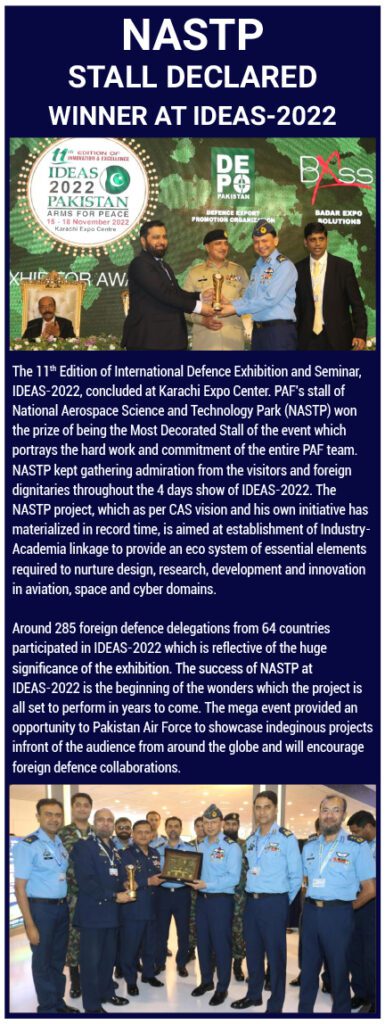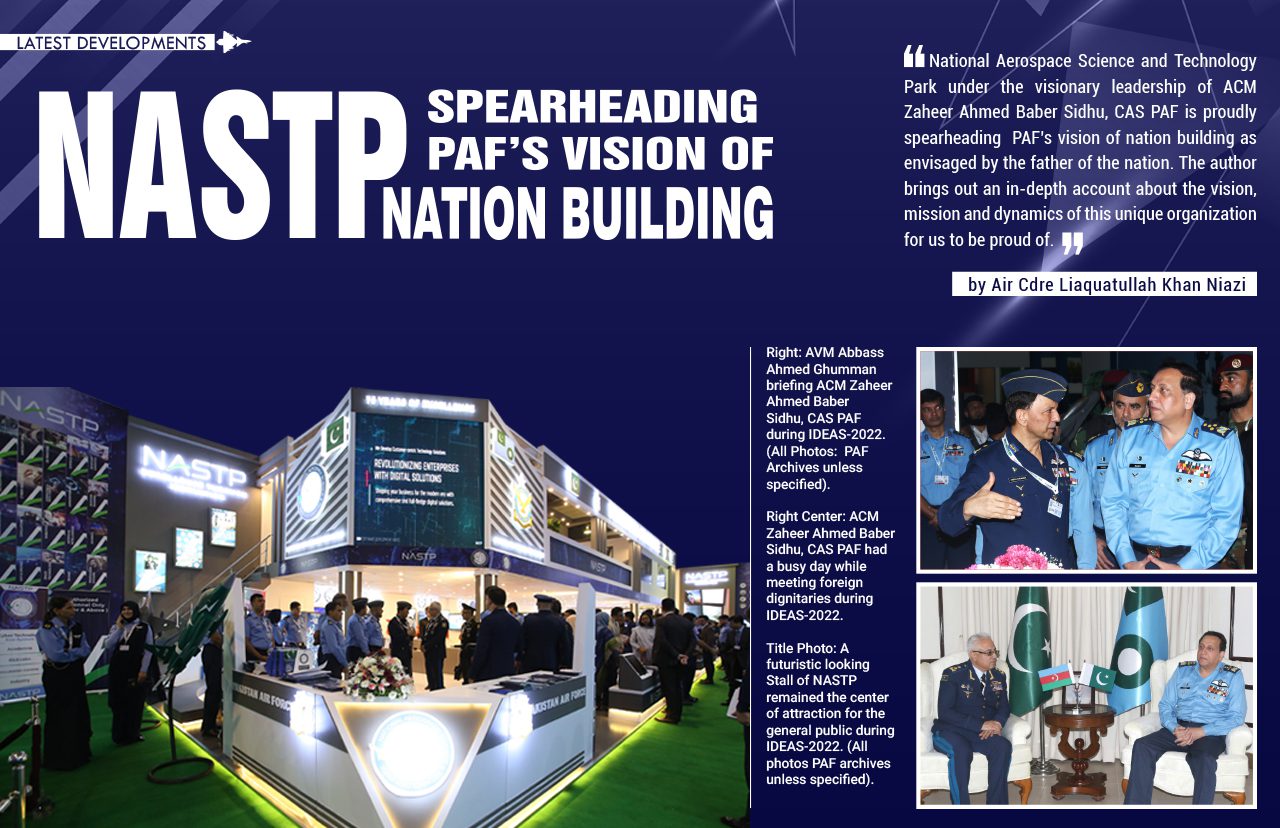National Aerospace Science and Technology Park under the visionary leadership of ACM Zaheer Ahmed Baber Sidhu, CAS PAF is proudly spearheading PAF’s vision of nation building as envisaged by the father of the nation. The author brings out an in-depth account about the vision, mission and dynamics of this unique organization for us to be proud of.
The 11th Edition of International Defence Exhibition and Seminar, IDEAS 2022 was held from 15th – 18th November, 2022 at Karachi Expo Centre. The mega event was significantly commemorated through enhanced participation of Pakistan Armed Forces, national and international defence industry, OEMs, entrepreneurs, and high level national and international defence delegations. The new features were aimed to make IDEAS an effective platform for defence Buyers and Sellers. Pakistan Air Force is the air warfare branch of the Pakistan Armed Forces which is tasked with providing, in synergy with other services, the most efficient, assured and cost-effective aerial Defence of Pakistan. Furthermore, Pakistan Air Force provides air logistic support capability and strategic air transport to the Pakistan Army, Pakistan Navy and various government departments on requirement basis. Pakistan Air Force also actively contributes in nation building efforts and thus poised on the threshold of tomorrow, PAF remains, “Second to None”; fully abreast with the indispensable mechanisms to live by its standards in the coming millennium and beyond.
PAF has been operating various types of aircraft since national independence including British, American, French and Chinese origin. While on one hand these aircraft and weapon systems have been providing the PAF with much needed war fighting capability, there have also been serious obsolescence and interoperability challenges apart from restrictions, embargos and export controls.
In order to mitigate these challenges, PAF leadership has been responding proactively by establishing MRO Depots as well as several R&D centers for core capabilities in data automation, sensor fusion, systems and weapons integration etc across Pakistan.
(a) AEDs are located in South with 75 – 100 years of excellence in Aerospace, Engines, Avionics, Aerostructure, MRO, Systems integration, testing, qualification, munitions manufacturing, simulators and AR / VR Systems etc.
(b) AEDs are located in North, specializing in ground handling equipment, special vehicles, radar MRO / upgrades, C-130 Mods / Upgrades, and multi-domain support including Robotics, EODs and MRO of Payloads.
(c) R&D Units undertake design, research and development in the fields of EW, EO/IR, ISR and Drone Systems.

Initially, most of PAF aircraft and systems were sent to their countries of origin for major overhauls and repairs, that resulted in loss of operational time in Beyond Country Repair (BCR), loss of foreign exchange and host of allied logistics and technical challenges. PAF leadership therefore, envisaged huge challenges in MRO of several types of fighter aircraft and Pakistan Aeronautical Complex (PAC) was established in 1973. PAC has evolved over last five decades from an MRO facility, setup for F-6 Aircraft, called F-6 Rebuild Factory (F6RF) in Kamra, into a huge complex of four factories over 2500 acres of land with 16000 skilled work force and more than 100000 population. Currently, PAC has the capacity to undertake MRO of all kinds of military and selected commercial aircraft, engines, radar and payloads as well as production of UAVs, trainer and fighter aircraft with flagship SMK and JF-17 Thunder.
The same activity also continued to synergize PAF organic R&D capability and PAF constituted its major R&D setup called Aviation Research, Innovation and Development (AvRID) as well as certification agency called PAF Air Worthiness Certification Authority (PACA).
Given establishment of the Projects Branch (now headed by three-star Air Marshal), AvRID, PACA and COEs of PAF Depots and Organic R&D Setups (NCW Tech, 606 Wing, Special Task Group, CoCS, CRDC etc), current PAF leadership has envisioned to establish National Aerospace Science and Technology Parks (NASTP) across Pakistan to nurture much needed Triple Helix Model. NASTP will provide eco-system of essential elements required to nurture design, research, development and innovation in the aviation, space and cyber domains, needed by the PAF to have supremacy in future warfare. Chief of the Air Staff PAF, Air Chief Marshal Zaheer Ahmed Baber Sidhu has provided overall vision and mission statement of the Project:-
NASTP Vision
Become one of the best Aerospace, Cyber & Computing Clusters in the world and transform national landscape with design, R&D and innovation centers for emerging and disruptive technologies.
NASTP Mission
Foster collaborative research, development and innovation in the fields of Aviation, Space, Cyber & Computing to ensure social, economic, technological and scientific benefits for Pakistan and our valuable partners.
NASTPs will be established at selected regional locations and shall have comprehensive set of elements of the overall eco-system of Project based on specific location, market analysis, presence of key industry, institutions, PAF Air Engineering Depots, private companies and engineering centers. Regional NASTPs shall aim to build mini-clusters around themselves comprising local industry, institutions, technology incubation centers and IT Parks etc.
NASTP Unveiling at GSTAR 2022

Global Strategic Threat and Response (GSTAR) is a biennial international forum initiated by CASS. This event brings national leadership, reputable international and Pakistani experts from think tanks, academia, defence services, intellectuals, and OEMs together at one platform. GSTAR 2022 was held on 19-20 October 2022. His Excellency President of Islamic Republic of Pakistan Dr Arif Alvi was the chief guest at the inaugural session on 19 October, 2022.
This day now holds a significant spot in the technological, economic and defence landscape of Pakistan, as worthy CAS declared the inception of National Aerospace Science & Technology Park (NASTP) at the GSTAR forum in the presence of national leadership, local industry and international audience. This unveiling garnered an immense interest and initiated a national-level dialogue on the far-reaching effects on the knowledge economy of Pakistan.
Overview of NASTP Alpha Rawalpindi
NASTP Alpha has following key elements:-
(a) NASTP Technology Divisions in Aircraft, Space, Radar, EW, EO/IR, Cyber, Computing, Advanced Airborne Comm Systems & Technologies, C2 Systems and Software Development
(b) NASTP Training Division with two flagship projects NASTP Aviation Academy and NASTP Instt of Technologies & Systems
(c) National Incubation Center for Aerospace Technologies (NICAT)
(d) Training and Incubation Center for Cyber & IT called Siber Koze with Turkish Collaboration
(e) PAF Air Worthiness Certification Authority (PACA)
(f) Center for Artificial Intelligence & Computing (CENTAIC)
(g) National Center for Cyber Security (NCCS)
(h) Certification Center with SISCO and HUAWEI Labs

(j) Hardware Certification Center ACAST
(k) Alpha Techno Square (ATS) for private companies and Daftarkhwan for Co-Working Spaces
(l) Amenities including but not limited to Banks, ATMs, Cafeteria, FMS, Day Care, Business Centers, Conference Rooms
Benefits, Advantages & Incentives of NASTP for the Private Sector
NASTP will thus provide following benefits to Academia and Industry:-
(a) Quality Human Resource.
(b) Linkages with national and international companies.
(c) Prototyping, Manufacturing, Product Certification, Testing and Qualification Services.
(d) Quality Training Courses as per the latest requirements of the industry.
(e) Technology Incubation. (f) Consultancy services from all of the aforesaid NASTP Divisions.
(g) Expos for products and services.
(h) Access to databases of companies, services, manufacturing and software houses.
(j) Data, Cloud Computing and HPC Services.
(k) Incentives for R&Ds.
(l) Startups Support – Trainings, Venture Capital, Endowments.
(m) Scholarships & Job creation.
(n) STZ benefits such as exemption on customs duties and taxation.








